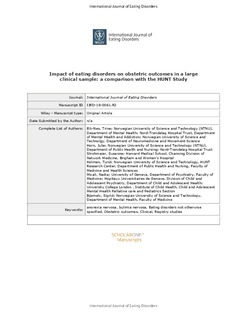| dc.contributor.author | Tetlie Eik-Nes, Trine | |
| dc.contributor.author | Horn, Julie | |
| dc.contributor.author | Strohmeier, Susanne | |
| dc.contributor.author | Holmen, Turid Lingaas | |
| dc.contributor.author | Micali, Nadia | |
| dc.contributor.author | Bjørnelv, Sigrid | |
| dc.date.accessioned | 2019-04-04T07:22:18Z | |
| dc.date.available | 2019-04-04T07:22:18Z | |
| dc.date.created | 2018-09-13T11:52:16Z | |
| dc.date.issued | 2018 | |
| dc.identifier.citation | International Journal of Eating Disorders. 2018, 1-10. | nb_NO |
| dc.identifier.issn | 0276-3478 | |
| dc.identifier.uri | http://hdl.handle.net/11250/2593223 | |
| dc.description.abstract | Objective
Current evidence from clinical studies suggests that having an active eating disorder (ED) during pregnancy is associated with unfavorable obstetric outcomes. However, the role of a lifetime diagnosis of ED is not fully understood. Variations in findings suggest a need for additional studies of maternal ED. This study aims to identify associations between a lifetime ED and obstetric outcomes.
Method
Data from a hospital patient register and a population‐based study (The HUNT Study) were linked to the Medical Birth Registry in Norway. Register based information of obstetric complications (preeclampsia, preterm birth, perinatal deaths, small for gestational age (SGA), large for gestational age (LGA), Caesarean sections, and 5‐min Apgar score) were acquired for 532 births of women with ED and 43,657 births of non‐ED women. Multivariable regression in generalized estimating equations was used to account for clusters within women as they contributed multiple births to the dataset.
Results
After adjusting for parity, maternal age, marital status, and year of delivery, lifetime history of anorexia nervosa was associated with increased odds of having offspring who were SGA (Odds ratio (OR) 2.7, 95% Confidence Interval (CI) 1.4–5.2). Women with a lifetime history of bulimia nervosa had higher odds of having a Caesarian section (OR 1.7 95% CI 1.1–2.5). Women with EDNOS/sub‐threshold ED had a higher likelihood of having a low Apgar score at 5 min (OR 3.1, 95% CI 1.1–8.8).
Conclusion
Our study corroborates available evidence on the associations between maternal ED and adverse obstetric outcomes. | nb_NO |
| dc.language.iso | eng | nb_NO |
| dc.publisher | Wiley | nb_NO |
| dc.title | Impact of eating disorders on obstetric outcomes in a large clinical sample: A comparison with the HUNT study | nb_NO |
| dc.type | Journal article | nb_NO |
| dc.type | Peer reviewed | nb_NO |
| dc.description.version | acceptedVersion | nb_NO |
| dc.source.pagenumber | 1-10 | nb_NO |
| dc.source.journal | International Journal of Eating Disorders | nb_NO |
| dc.identifier.doi | 10.1002/eat.22916 | |
| dc.identifier.cristin | 1609149 | |
| dc.description.localcode | Locked until 6.9.2019 due to copyright restrictions. This is the peer reviewed version of an article, which has been published in final form at [https://doi.org/10.1002/eat.22916]. This article may be used for non-commercial purposes in accordance with Wiley Terms and Conditions for Self-Archiving. | nb_NO |
| cristin.unitcode | 194,65,35,0 | |
| cristin.unitcode | 194,65,20,0 | |
| cristin.unitname | Institutt for psykisk helse | |
| cristin.unitname | Institutt for samfunnsmedisin og sykepleie | |
| cristin.ispublished | true | |
| cristin.fulltext | original | |
| cristin.qualitycode | 2 | |
